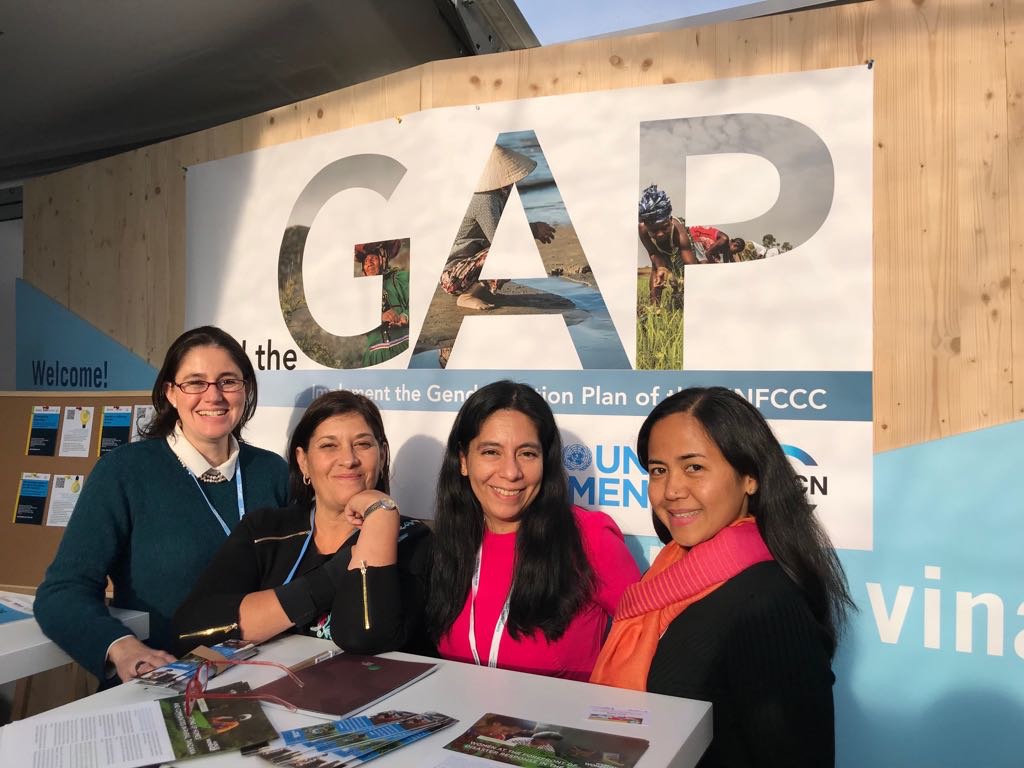The UNFCCC affirms its commitment towards capacity building and tracking progress on gender
At the Bonn UNFCCC Intersessional, IUCN supports delegates in taking steps on implementing its recent Gender Action Plan

IUCN and UN Women at COP 23 promoting the implementation of the recently adopted UNFCCC Gender Action Plan.
Photo: IUCN
On the occasion of the 48th subsidiaries bodies session, the COP 23 Presidency and UNFCCC Secretariat initiated discussions on the operationalisation of its recent Gender Action Plan (GAP) adopted last year. The UNFCCC GAP not only formally recognises the differentiated impacts of climate change on women and men but supports the more than 60 UNFCCC decisions related to gender, particularly the advancement of women's participation in decision making and systematising measureable steps forward in integrating gender throughout adaptation measures.
Last week, discussions focused specifically on how to raise awareness about the GAP, its priority areas, as well as how to mobilise financial resources and technical expertise required for the successful implementation of the UNFCCC GAP. In addition, National Gender Focal Points (NGFPs) and Heads of Delegation discussed ways to identify and discuss opportunities and challenges in the implementation of the UNFCCC GAP. To this end, NGFPs and Heads of Delegation convened to map out capacity-building needs, including tangible ways they could support the needs of relevant organisations, and formalised a call for all delegations who have not yet nominated a NGFP to do so.
IUCN supported the above capacity-building mandates through in-session workshops on gender, particularly highlighting the need to continue to enhance gender statistics and indicators to operationalise the 2030 Agenda. Through its Environment and Gender Information (EGI) platform and partnership with UN Environment on gender and environment statistics, IUCN is continuing to push the dial on measuring the impact of gender in the environment.
The EGI began as an index at COP 19, but its development highlighted a deep gap in sex-disaggregated data, becoming a platform in 2013. Since this change, the EGI has developed more than 15 datasets and tracking national reports submitted to all Rio Conventions. The EGI is a comprehensive platform that aims to convey the value of gender equality data and information through and for the benefit of environmental conservation and sustainable development. It is a powerful resource to influence, encourage and assist governments and civil society to propel gender-responsive environmental policies, practice and communication. In searching for sex-disaggregated data, IUCN found that such information does not exist in sectors such as forestry, agriculture, water, energy, disasters and infrastructure.
This gap is significant as it means implementation of global international agreements on gender and the environment like the UNFCCC GAP is lacking in many places, finding that 40% of Nationally Determined Contributions (NDCs) mention gender issues. Studying National Biodiversity Action Plans (NBSAPs) from 1993-2016, only 56% include gender or women key words, of which only 4% referred to women as agents of change. In the case of NBSAPs, once IUCN understood the gaps, IUCN supported individual countries in integrating gender considerations into their NBSAP submissions. For instance, Brazil went from zero gender mentions to 37 as a direct result of this engagement.
Furthermore, IUCN’s studies on Sustainable Energy for All (SEforALL) revealed that only 2% of submissions positioned women as agents of change, contributing directly to the establishment of a People Centered Accelerator to identify and close these gaps on gender equality as well as access and inclusion of indigenous peoples and vulnerable groups to energy and energy opportunities.
Moving forward, IUCN is in the midst of a collaboration to map gender indicators for Sustainable Development Goals (SDGs) by working with countries like Lao PDR, Kenya and Mexico and the Inter-Agency Expert Group on Gender Statistics (IAEG-GS). This project will measure gender and the right to land, natural resources and biodiversity; access to food, energy, water and sanitation; climate change, sustainable consumption and production, and health and well-being; and women in environmental decision making.
Taken together, these efforts will support the UNFCCC in ensuring it implements its mandate to collect sex-disaggregated data on the differentiated impacts of climate change on women and men, with special attention paid to local communities and indigenous peoples and the integration of gender into adaptation and mitigation plans and policies. As IUCN’s Lorena Aguilar submitted to workshop participants, “You cannot manage what you do not measure.”
You can learn more about IUCN's work on gender and the environment at http://www.genderandenvironment.org/



